The world of social media marketing is constantly changing, introducing new trends and technologies that open a world of opportunities for digital marketers.
Recent statistics show that more than half of the world’s total population uses social media, and platforms like Instagram and TikTok are becoming essential tools for engagement. This rapid growth highlights the importance of a robust social media strategy for schools to connect with their audience effectively.

Unsurprisingly, it can be overwhelming. Schools might struggle to keep the big picture in mind, leading to fragmented online presence and incoherent messaging that doesn’t connect with the target audience.
To prevent this, you need to focus on the element that ties all of your social media efforts together: your overall social media strategy.
Implementing a social media marketing strategy for schools isn’t easy, but doing so will ensure that your posts contribute to your overall recruitment goals, whether that be to build your reputation, enroll more students, or any other objective you identify.
Whether you’re looking to create or tweak your school’s social media strategy, this blog will walk you through the steps of implementing a winning social media strategy that is targeted to your school’s prospective students.
1. Persona Creation is an Integral Part of a Social Media Marketing Strategy for Schools
Before you start thinking about creating social media posts, you should consider who they are for.
In digital marketing for schools, this process is called ‘persona creation’ and involves creating a fictional character based on your school’s typical prospective students. Personas help you craft social media posts that are optimally relevant to your target audience.
Personas are composed of a wide variety of information, from demographic info to psychographic data that you gather through admissions experience and research.
For schools, a robust approach to creating personas starts with a thorough examination of your typical students’ background information. This includes identifying where they are from, their age range, the languages they speak, and their gender. Additionally, delve into their socioeconomic status, educational background, interests, and extracurricular activities.
Understanding these factors helps to construct detailed and accurate personas, allowing for a more targeted and effective digital marketing strategy for schools. By aligning your social media content with the specific needs and preferences of these personas, you can enhance engagement and better address the unique challenges faced by your student population.
Example: Sample background information for an international student persona.

The next step is to contemplate the things that your persona is looking for in a school, as well as the things that may hold them back from studying at a particular institution.
Here at HEM, we call these components “motivations” and “concerns.” These are optimally useful for a social media marketing strategy for schools, giving you the information you need to craft messaging that better resonates with your target audience. For maximum impact, you can use these motivations and concerns to determine what aspects of your school you should foreground on your social media, as well as what pain points you may need to assuage.
Example: Motivations and concerns for a sample persona. The more factors you list, and the more specific these factors are, the more helpful your personas will be when creating your school social media posts.

Once you’ve gone through the persona creation process for one type of prospect, you may want to repeat the process with different types of typical students.
How many personas you should create is unique to your school and its audience. Some schools have four, some have one—there’s no ‘right answer.’
Since personas are meant to help guide a social media strategy for schools, they should always be a help and not a hindrance. If you find that it’s too difficult to pigeonhole your posts towards one persona, it’s a sign that you need more. But if you are finding that your posts address multiple personas, and you find it difficult to create content for one specific persona, it’s a sign that you have too many.
2. Integrate Student Persona Insights into Your School Social Media Posts
Now that you have a highly specific and in-depth understanding of your prospective students, the next step is to put yourself in their shoes and think about the kind of content they are looking for on social media.
To come up with different types of posts at this stage can be difficult, so we’ve found it helpful to first create “key messages” for each motivation and concern you’ve listed.
Essentially, “key messages” are statements that address a prospect’s motivation or concern, and show why your school is the right choice for them.
Example: Key messages based on a sample persona for an online learner. As you can see, the key message for the motivation shows how the school provides what the student needs, and for the concern, the key message shows how this isn’t something the prospect has to worry about at this school.

When you’ve got the key messages down, you can start thinking about how to bring them to life through social media posts.
This could involve planning what sort of visuals best fit with certain messages, or the kinds of captions and posts that would best express your key messages. The result will lead to a stronger social media marketing strategy for schools.
Example: An Instagram post from EC English that perfectly articulates a key message about the language school’s teaching methodology.

Source: EC English
While some key messages are easy to transform into social media post ideas, others may take more finesse.
For instance, if you want to highlight statistics that solidify your school’s reputation, but still want the tone of your social media posts to come off as friendly and welcoming, you could create a post like the one below from McGill University.
Example: An Instagram post that showcases McGill’s achievements paired with a fun, student-centred photo.
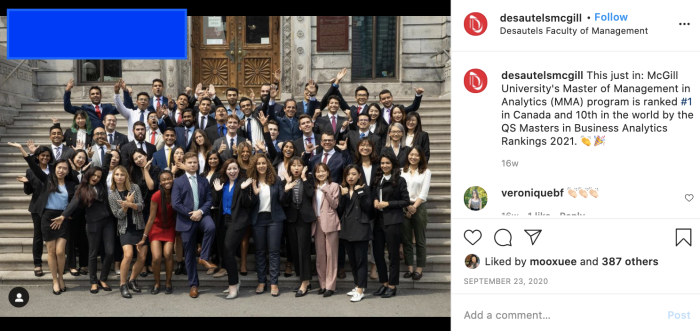
Source: Desautels McGill
It can also be helpful for your school to browse the social media channels of its competitors to see how they’re addressing student motivations and concerns. Gathering as many post ideas as possible will make it much easier to come up with content later down the line.
From there, your school may want to assemble these findings into a document that you can use for future reference. You could create sample posts for each key message, for instance, or create a list of different elements that a post should include for a certain persona.
It is important to keep in mind that, in the current social media landscape, short videos have emerged as one of the most effective ways to engage with audiences, so you might want to make sure to include a few of these when creating sample messages or planning future posts. Platforms like TikTok, Instagram Reels, and YouTube Shorts have skyrocketed in popularity, particularly among younger demographics, so make sure to check what kind of content your persona is more likely to engage with.
3. Identify the Channels and Content Types that Best Suit Your School Social Media Plan
Not only are there a number of different social media channels out there—each one also allows schools to create a wide range of posts.
From Stories to videos to link shares and carousel posts, schools can choose from a wide variety of content types to express their key messages.
When crafting a social media marketing strategy for the marketing of schools, it is important to keep these factors in mind. For one, this will make your strategy more effective and targeted. Secondly, it will ensure that your school is devoting its resources towards the initiatives and channels that are likely to have the biggest impact.
Your personas can help you answer a common question we hear at HEM: What is the best social media platform for schools? The best platform largely depends on where your prospective students spend their time online. For instance, if your personas are budding professionals, a solid LinkedIn presence is essential. If your prospects are looking for a fun, welcoming school that offers plenty of on-campus activities, you may want to consider investing in TikTok marketing.
Example: University of Limerick graduates trying their hand at the famous TikTok #handclapchallenge. Taking part in social media challenges shows that your school makes an effort to promote community, both on campus and on social media.
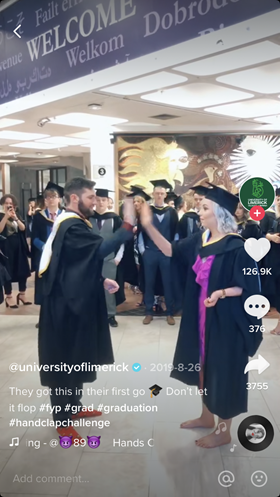
Source: University of Limerick
When it comes to the types of content you’re posting on social media, consider first the types of content that would best express your key messages.
For instance, if you want to showcase your school’s academic reputation, sharing articles related to your school’s or its students’ successes is a great way to do so while simultaneously building your social media presence.
Example: A LinkedIn post from Cambridge University Department of Chemical Engineering and Biotechnology.

Source: University of Cambridge
Keep in mind that certain types of content take longer to craft than others. For instance, it’s relatively quick and simple to create the above post. All the school needed to do was find a relevant article and craft a short caption.
However, it takes significantly longer to create video content. You need to plan the video in advance, as well as set aside time to film and edit it.
The same—potentially—goes for student-centered content. If you don’t already have a group of students willing to contribute social media content, or even ‘takeover’ your social channels for a day, it can be difficult to generate these types of posts.
With that being said, a student-centered social media marketing strategy for schools can be used to help convert more prospective students. It may be worth taking the time to assemble a social media team or select student social media ambassadors.
This situation can be a win-win for both your school and your current students. Depending on your school, it’s likely that many of your students are looking for resume-boosting extracurriculars, so getting your students involved in your school social media plan can provide them with valuable experience.
4. Create a Posting Schedule for Your Social Media Marketing Strategy for Schools
The previous steps have predominantly been planning-based. Now, we’ve got to the part where you can bring your blueprint to life through an actionable strategy.
If you’ve ever wondered, “How to market your school on social media?” this section is key. Once you define your personas and platforms, creating a consistent posting schedule is crucial for a successful social media marketing strategy. By planning and scheduling your posts, you ensure regular engagement with your audience, maintain a steady flow of content, and strategically align your messages with key events and enrollment periods. Here are a few steps you can take to get started.
First, figure out how many posts you want to share each week, and across which channels. If you’ve determined that Instagram is the most important platform for your school, you may want to post there fairly frequently, while only posting a couple of times on other social networks.
Then, it may be helpful for your school to cross-reference your posting schedule with your admissions calendar. You may want to plan for additional posts leading up to key deadlines, and then loosen up on your posting schedule right after the deadlines pass. This way, you never have to scramble at the last minute to create content!
Example: Here’s an example of a content calendar that includes sections for dates and keywords along with dedicated columns for each key social media channel. Tools like this make it much easier to plan and keep track of content, leading to an effective social media marketing strategy for schools.
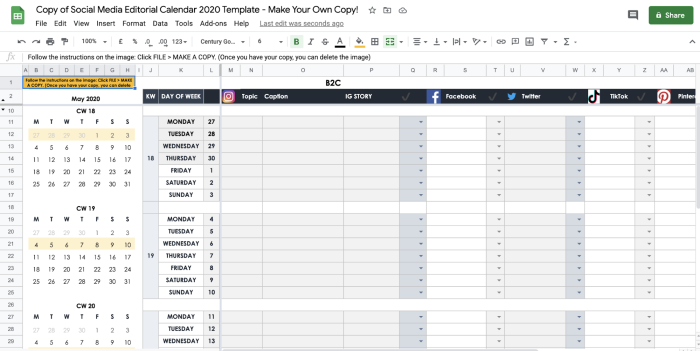
If you want to be super-organized, you could also categorize your social media schedule by post type. This ensures that your school will target its various personas each week. It will also help your school build a robust social media presence across key channels, as you can plan in advance for different types of content such as videos, live streams, and more.
Of course, it’s impossible to create or keep an exact social media schedule. There will always be unexpected moments to capture and new initiatives to promote—not to mention new trends constantly emerging. This dynamism is the beauty of social media for schools!
5. Explore Software to Help Organize Your Social Media Marketing Strategy for Schools
At this point in the process, you have a comprehensive social media schedule in your toolkit. However, you may be looking at it thinking: “how are we going to ensure that each post goes out on the right day at the right time?”
This can be especially concerning since research shows that different posting times work better for certain social media platforms than they do for others. For example, social media posts on Instagram would perform better on weekday mornings, while posts on Facebook see higher engagement from 8 AM to 12 PM on Tuesdays and Thursdays.
However, post scheduling tools provide a solution. Certain social media channels offer built-in features that allow you to schedule your posts in advance, allowing you to automate this entire process.
Example: Facebook’s scheduling tool, which is available through your school’s Meta Business Suite account, allows you to schedule posts for your Facebook and Instagram accounts.

A benefit of using these types of tools is that you can schedule posts at specific times on certain days.
If you want to ensure that posts appear on your prospects’ news feeds when they’re likely online, and your prospects live in different time zones than you, it will be virtually impossible to manually get posts out at the right time (unless you are fine with waking up at midnight to share a post!). Scheduling tools can help resolve this problem, strengthening a social media marketing strategy for schools by ensuring that the right posts are going out on the right channels at the right time.
Now, there is one major drawback to native social media scheduling tools. With the exception of Facebook, schools are only able to schedule posts for one particular platform. This means you have to coordinate scheduling across a number of different platforms, making your lives more difficult and increasing the risk of errors.
That’s where social media software comes in. There are a number of different programs that allow schools to not only schedule their social posts across channels, but also monitor their results–streamlining social media marketing for schools.
Programs like HubSpot, Hootsuite, Buffer, Social Pilot, and Agorapulse are designed specifically for this purpose. Although you may have to pay a monthly fee for the full version of some of these platforms, the ability to manage and track your social media performance across channels is extremely valuable in the long term.
Example: The social media scheduler in HubSpot. You can create posts across Facebook, Instagram, Twitter, and LinkedIn. You can also organize content by campaign in order to view results across a certain set of posts. By using HubSpot’s marketing tool in this way, you can even create a custom social publishing schedule.
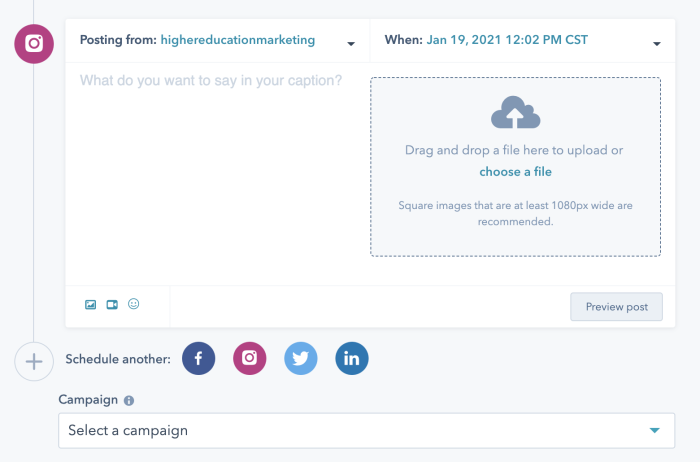
HubSpot, like many other marketing automation programs, also offers plenty of social media reports that allow you to analyze your performance on individual campaigns, channels, or both. Here, you may find HubSpot’s own guide on creating a social media report helpful.
Example: A HubSpot social media report across a certain timeframe. You can also compare results over different date ranges.
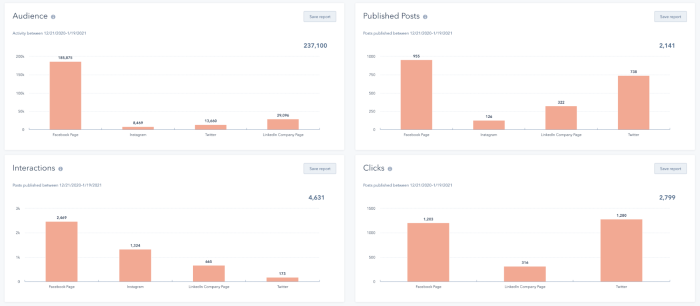
If you want to properly implement a social media marketing strategy for schools, it’s important to consider every element from start to finish—or, in other words, from your student personas to social media reporting. The better you understand your target audience, and the more organized your social media schedule is, the more likely you are to see positive results at the end of the day.
*This post was originally published in 2021, but has been updated and expanded to reflect the latest trends and developments in the industry.
FAQ:
How to market your school on social media?
Once you define your personas and platforms, creating a consistent posting schedule is crucial for a successful social media marketing strategy.
What is the best social media platform for schools?
The best platform largely depends on where your prospective students spend their time online.







